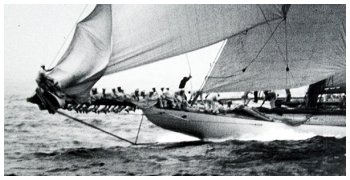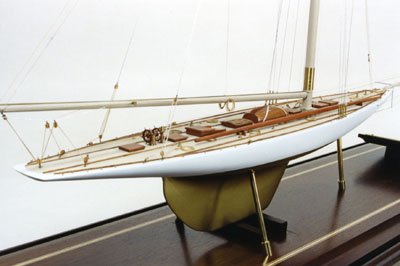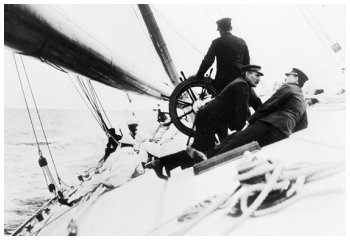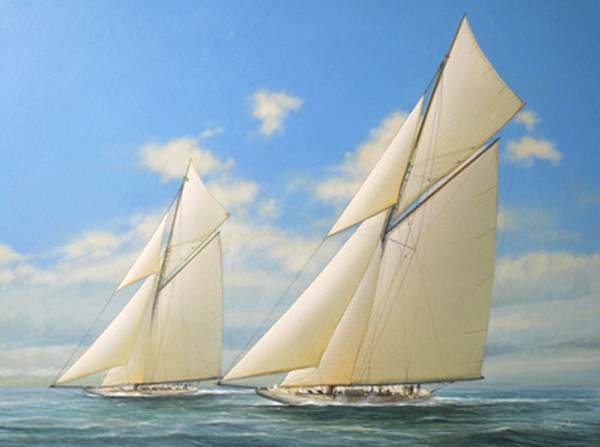Yves GARY Hits: 7675
Category: RELIANCE
 The twelfth defender of the America's Cup
The twelfth defender of the America's CupReliance has been designed for the twelfth edition of the America's Cup for race against the third challenger of Sir Thomas Lipton. She was the fourth defender from the famous designer Nat Herreshoff, and reportedly the largest gaff-rigged cutter ever built. Reliance was built at Herreshoff Manufacturing Company for...
... a syndicate of the New York Yacht Club composed of Cornelius Vanderbilt, William Rockefeller, Elbert H. Gary, Clement A. Griscom, James J. Hill, W. B. Leeds, Norman B. Ream, Henry Walters, and P. A. B. Widener.
 Reliance was designed to take full advantage of the Seawanhaka '90-foot' rating rule and was regarded as a "racing freak", suitable only for use in certain conditions. She was the first racing boat to be fitted with winches below decks, in an era when her competitors relied on sheer man-power. Despite this she carried a crew of 64 for racing due to her large sail plan.
Reliance was designed to take full advantage of the Seawanhaka '90-foot' rating rule and was regarded as a "racing freak", suitable only for use in certain conditions. She was the first racing boat to be fitted with winches below decks, in an era when her competitors relied on sheer man-power. Despite this she carried a crew of 64 for racing due to her large sail plan.
The Reliance had been  launched April 12th, and even in her sail stretching spins showed evidence of great speed, particularly in smooth water and light airs. On board Reliance was C. Oliver Iselin, who had once more been persuaded to take up the task of managing a cup defender. This time no mistake was made in the choice of a skipper, and Charley Barr was found in charge of her quarter deck, with a big crew of Scandinavians.
launched April 12th, and even in her sail stretching spins showed evidence of great speed, particularly in smooth water and light airs. On board Reliance was C. Oliver Iselin, who had once more been persuaded to take up the task of managing a cup defender. This time no mistake was made in the choice of a skipper, and Charley Barr was found in charge of her quarter deck, with a big crew of Scandinavians.
For the trial races, Reliance is confronted to Columbia, the winner of 1899 and 1901, and Constitution,  the unlucky boat of 1901. The
the unlucky boat of 1901. The  first meeting between the three boats took place on May 5 and, throughout the summer, Reliance proved herself the fastest, beyond a doubt. The general result of these races showed Reliance to be about ten minutes faster than Columbia in light weather, and about three minutes faster in a strong breeze and sea, over a thirty-mile course. With her immense sail area Reliance heeled to her sailing lines in about a seven-knot breeze which, of course, made her very fast in light airs; yet in breezes up to twelve- knots' strength she was still powerful enough not to bury her lee rail except when caught broad off with sheets amidships.
first meeting between the three boats took place on May 5 and, throughout the summer, Reliance proved herself the fastest, beyond a doubt. The general result of these races showed Reliance to be about ten minutes faster than Columbia in light weather, and about three minutes faster in a strong breeze and sea, over a thirty-mile course. With her immense sail area Reliance heeled to her sailing lines in about a seven-knot breeze which, of course, made her very fast in light airs; yet in breezes up to twelve- knots' strength she was still powerful enough not to bury her lee rail except when caught broad off with sheets amidships.
Three official trial races were arranged off Newport, beginning July 27th. Reliance won the first race, beating Columbia by 46 seconds and Constitution by 2 minutes and 29 seconds. This was the only official trial race held, as the Cup Committee formally selected Reliance to meet Shamrock III.

 - from August 20th to September 3rd, 1903, at New York.
- from August 20th to September 3rd, 1903, at New York.
- the contest was to be decided by the winning three races out of five.
- the first, third and fifth races to be to windward and leeward, the second and fourth over a triangle, all courses to be thirty miles, and laid to windward when possible.
- starting signals to be given at 11 o'clock, and delayed only in event of changing the starting-point, fog, or agreed postponement; preparatory gun to be fired ten minutes before starting signal, and handicap gun two minutes after.
- the race may be postponed in the discretion of the Regatta Committee, unless either contestant shall insist on its being started.
- time limit for races five and a half hours.
- vessels to be allowed time for repairs in case of an accident.
- yachts to be measured with all weights on board to be carried in a race, restrictions as to bulkheads, floors, doors, water-tanks and anchor being waived.
Reliance is confronted to Shamrock III, the challenger of Royal Ulster Yacht Club.
Six races disputed.
Three races canceled : time limit.
Reliance beat Shamrock III three wins to nil.
- August 22nd, 1st race, 30 miles, windward-leeward : Reliance beat Shamrock III by 7 mn 3 s corrected time.
- August 25th, 2nd race, 30 miles, triangle : Reliance beat Shamrock III by 1 mn 24 s corrected time.
- September 3rd, 3rd race, 30 miles, windward-leeward : Shamrock III did not finish in the fog. Reliance elapsed time : 4h 28 mn 06s.

The victorious Reliance, bedecked with flags from bowsprit to topmast and from the topmast to the tip of the boom, left her Sandy Hook moorings at 8 o'clock yesterday morning and passed triumphantly up the bay, between Forts Wadsworth and Lafayette, around the Battery, under the Brooklyn Bridge, and up the Sound to New Rochelle, where she anchored off All View, Mr. Iselin's residence at Premium Point. Reliance will remain at New Rochelle for two or three days and then will go to City Island to be hauled out for the Winter.
"BROOKLYN. July 2 [1914]. The famous old cup defender Reliance, the largest, and probably, on the whole, the fastest of all the long line of white winged flyers that in their time have sailed for the America's cup, left her native element yesterday afternoon for the last time in Furman's shipyard [Furman Dry Dock Company] and by the same time this afternoon little will be left of her graceful lines but piles of scrap metal. There was no ceremony, nor were there any mourners, when the old yacht was hauled reluctantly up the creaking ways, down which she'll never slide again. Michael Cowhey, a Brooklyn junkman, who bought the yacht in from Adrian C. Iselin last December, had her towed around from Robbins' drydock in Erie basin, where she has been lying, and inside of an hour the Reliance was high and dry, awaiting the onslaught of the wreckers who will dismember her.
(Source: Anon. "Old Reliance Goes To The Scrap Heap." New London Day, July 2, 1914, p. 14.)
